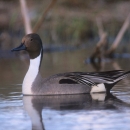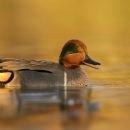Featured Species
The Wallkill River National Wildlife Refuge is home to a variety of wildlife and habitats.
Waterfowl: The refuge provides important year-round habitat for migrating and breeding waterfowl, the numbers of which are especially impressive in spring. Once the refuge’s managed impoundments (viewable from the Liberty Loop trail) are ice free, large numbers of waterfowl begin their northward migration. At its peak, two to three thousand Northern pintails, two thousand green-winged teal and up to one thousand ring-necked ducks can be found here. These are joined by smaller numbers of blue-winged teal, American black duck, mallard and Northern shoveler. Also of interest are the occasional redhead, canvasback and tundra swan. Mallards, wood ducks, green-winged teal, mergansers and black ducks remain as summer residents.
Grassland Dependent Birds: The refuge and the Kittatinny Valley maintain a greater concentration of grassland birds than in most other areas of the State. Grassland birds can be found in many of the open fields on the refuge during the nesting season. The most distinct of these is the bobolink, though you may also encounter grasshopper sparrow and eastern meadowlark. The wooded edges of many refuge fields are host to a number of migratory songbirds such as indigo bunting, field sparrow and eastern bluebird. In winter, raptors are a big attraction for wildlife photographers and observers alike. Northern harriers, rough-legged hawks and short-eared owls can be found around the Liberty Loop and Winding Waters trails while red-tailed hawks (present year-round) are ubiquitous across the refuge.
Wetlands: The Wallkill River valley has been known for its swampy wetlands since the earliest settlers arrived in the 1600’s. Known as “The Drowned Lands”, the lands along the river valley were perpetually swampy as a result of the topography formed by the last glacial period. What remains of these wetlands (ditched and drained by years of agriculture and development) comprise the dominant habitat type on the refuge. These wetlands provide important habitat for wood frogs, spotted salamanders, and the federally threatened bog turtle, as well as a wide variety of birds. Without management, these marshes and wetlands would eventually fill in with dense wetland shrub and red maple swamps.
Grasslands: Modern development and suburbanization has greatly threatened grasslands as a habitat type throughout the northeast. Large, expansive grasslands originally created by agriculture practices no longer exist throughout much of this area. As a result, populations of grassland-dependent species have decreased greatly over time. The historical prominence of farming in the Wallkill Valley gives the refuge an opportunity to create a different story. Local history and culture is incorporated into refuge management, with farmers actively haying fields after the nesting season. The refuge also plants native warm season grasses in these areas to improve grassland quality for both farmers and wildlife.
Floodplain Forests: Riparian woodlands are a significant element on the refuge. Historically, the Wallkill River corridor would have been dominated by hardwood forests in and around the river’s wetlands. However, as settlers arrived, much of the land was cleared for farming and grazing. Some old fields along the river are reverting naturally to hardwood forest; however, others are inhibited by the presence of non-native, invasive species invasive species
An invasive species is any plant or animal that has spread or been introduced into a new area where they are, or could, cause harm to the environment, economy, or human, animal, or plant health. Their unwelcome presence can destroy ecosystems and cost millions of dollars.
Learn more about invasive species that prevent woody growth. The refuge restores these areas by planting native saplings which are better able to compete against thick, tall invasive grasses. In time, the young trees will shade out the grasses and help encourage additional reforestation along the river.



